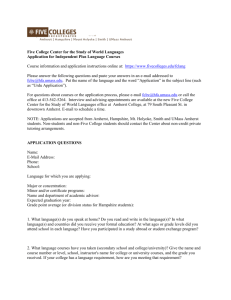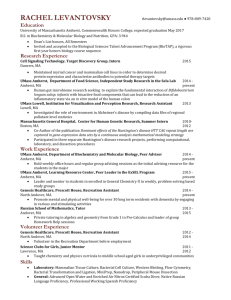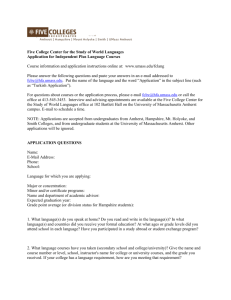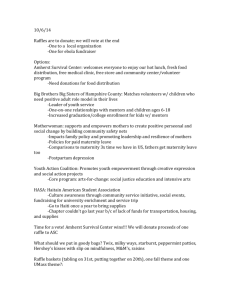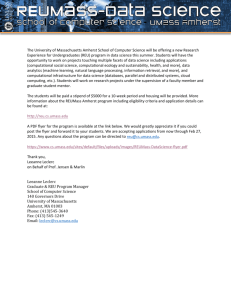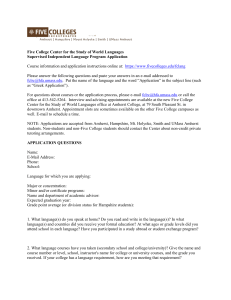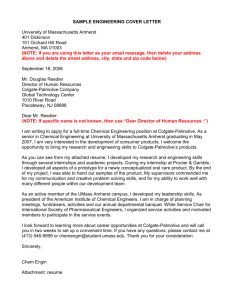PDR Presentation Slides
advertisement
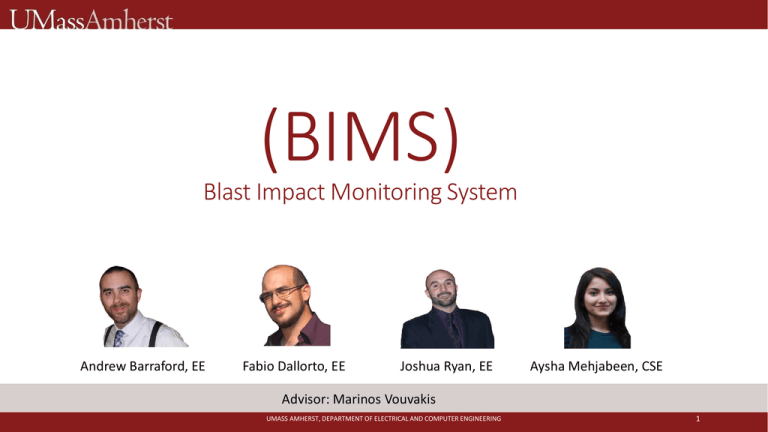
(BIMS) Blast Impact Monitoring System Andrew Barraford, EE Fabio Dallorto, EE Joshua Ryan, EE Aysha Mehjabeen, CSE Advisor: Marinos Vouvakis UMASS AMHERST, DEPARTMENT OF ELECTRICAL AND COMPUTER ENGINEERING 1 (IMS) Network of 4 modular sensors Data storage hub UMASS AMHERST, DEPARTMENT OF ELECTRICAL AND COMPUTER ENGINEERING 2 Blast Characteristics UMASS AMHERST, DEPARTMENT OF ELECTRICAL AND COMPUTER ENGINEERING 3 Made Contact with the following experts with Shock Tube Labs • Dr. Jerry Shan, Rutgers University. Available Dec/Jan • Dr. Michael Courtney, BTG Research. Available Anytime • Dr. Chandra, New Jersey Institute of Technology. TBD Tested Piezoelectric Film • Voltage Response over varied lengths wired of 5ft and 0 feet (attached to probe)- Results in minimal attenuation. • Collected voltage response from direct impact due to weight. • Next Step: Collect sensor response in shock tube, under varied situations. UMASS AMHERST, DEPARTMENT OF ELECTRICAL AND COMPUTER ENGINEERING 4 Problem Statement • Impact of blast waves on the body are a cause of Traumatic Brain Injury (TBI) • Traumatic Brain Injury (TBI) is more treatable the earlier it is detected. • Rapid pressure change, driving kinetic energy through the blood veins cause TBI.[1] • Research suggests impacts to the body result in TBI caused by bleeding in the lungs (Blast Lung) that leads to hypoxia.[1] • Current focus of monitoring devices is on the head. • More portable data collection instruments are needed.[2] Currently there is no device for field data acquisition to aid in correlating levels of forces seen at the body with TBI. [1] Cernak and Noble-Haeusslein. "Traumatic Brain Injury: An Overview of Pathobiology with Emphasis on Military Populations."National Center for Biotechnology Information. U.S. National Library of Medicine, 07 Oct. 2009. CDC, NIH, DoD, and VA Leadership Panel. “Report to Congress on Traumatic Brain Injury in the United States: Understanding the Public Health Problem among Current and Former Military Personnel.” Centers for Disease Control and Prevention (CDC), the National Institutes of Health (NIH), the Department of Defense (DoD), and the Department of Veterans Affairs (VA). 2013. [2] The UMASS AMHERST, DEPARTMENT OF ELECTRICAL AND COMPUTER ENGINEERING 5 Effect on the Individual Mild Symptoms of TBI: [3] • Headache • Confusion • Lightheadedness • Dizziness • Blurred Vision • Ringing in Ears • Tiredness • Mood Changes • Trouble with Memory, Concentration, or thinking • Sensitivity to light and Sound • Nausea or Vomiting “Some moderate to severe TBI symptoms last for a longer period of time or may be permanent.” www.Maketheconnection.com [3] "Mild TBI Symptoms." Editorial. TraumaticBrainInjury.com. N.p., n.d. Web. 16 Oct. 2014 . UMASS AMHERST, DEPARTMENT OF ELECTRICAL AND COMPUTER ENGINEERING 6 Societal Impact • • • • • • • 2.5 Million people have served in Iraq and Afghanistan.[4] 19.5% Of soldiers may suffer from brain injury.[5] Since 2000 - 307,283 cases of TBI.[6] Many people who get a TBI develop PTSD.[7] Economic burden of $60 Billion (2000).[2] Affects families Effected often struggle with jobs and relationships The effects of TBI are felt beyond the individual, emotionally for the family and economically for the rest of the society. [4] "Invisible Wounds Mental Health and Cognitive Care Needs of America’s Returning Veterans." RAND Corporation. RAND Center for Military Health Policy Research, 2008. [5] Adams, Chris. "Millions Went to War in Iraq, Afghanistan, Leaving Many with Lifelong Scars." McClatchy Newspapers, 14 Mar. 2013. [6] "DoD Worldwide Numbers for TBI." Defense and Veterans Brain Injury Center. N.p., 2014. [7]”Traumatic Brain Injury: A Guide for Patients” (n.d.): n. pag. CogSMART Program of the VA San Diego Healthcare System. UMASS AMHERST, DEPARTMENT OF ELECTRICAL AND COMPUTER ENGINEERING 7 Our Solution • A wearable data acquisition device to track and log the forces seen by soldiers in the field to later be used to correlate any resulting TBI. • This data may lead to future early detection enabling earlier intervention. “Early detection with better diagnostic tools also can lead to better outcomes when paired with timely interventions. “ 2013 Congressional Report UMASS AMHERST, DEPARTMENT OF ELECTRICAL AND COMPUTER ENGINEERING 8 Design Requirements/Specs Inputs and Outputs Requirements Device Requirements • Must be lightweight and ultra portable • Must be able to fit into existing clothing • Transmit Data wirelessly to hub • Collect pressure(impact) data. • Display impact data on multiple platforms. • Third party modification must be in mind when developing software. Inputs: • Pressure (psi) Outputs • Data from impacts • Voltage output of sensors over time • Multi-Platform Visual Representation • Either voltage alone or also its corresponding pressure UMASS AMHERST, DEPARTMENT OF ELECTRICAL AND COMPUTER ENGINEERING 9 Current Market Solutions • Intelligent Tactical Vest – WPI SDP 2011, This vest monitors for ballistic impacts and calls for help. Identical functionality to S911 model below S-911 Vest, Laipac Technologies • Detects Ballistic Impacts • Sends GPS coordinates Army Research has developed ear buds to track head impacts (Not official, nor is there any data available). Current solutions do not monitor the forces seen at the body due to explosions. UMASS AMHERST, DEPARTMENT OF ELECTRICAL AND COMPUTER ENGINEERING 10 Design/Solution Alternatives: Hardware Input Sensing: • Piezoelectric Film • Accelerometers • Discrete Pressure Sensors Data Transmission: • Bluetooth • RFID • Wired Monitoring: • External Pressure • Monitor Blood Pressure • Monitor Blood Oxygen Levels We are planning to use Piezo film as sensors to monitor pressure applied to the body externally. An effective calibration strategy has to be implemented. UMASS AMHERST, DEPARTMENT OF ELECTRICAL AND COMPUTER ENGINEERING 11 Design/Solution Alternatives: Software Application Options • Windows Based (Non Cloud Based) • Windows Based (Cloud Based) • Android • iOS • Windows Phone • JAVA • ASP.NET • PostgreSQL • SQL Server (MS) • MySQL We are planning to implement a cloud based backend/end point, using JAVA, for a Windows application and an Android mobile app. UMASS AMHERST, DEPARTMENT OF ELECTRICAL AND COMPUTER ENGINEERING 12 Our Solution: Block Diagram Sensing, Signal Processing, and Power Input Piezo Film Sensor Amplification/ Filtering Power A to D Processing Android Application Graphical Data View Outputs Application Endpoint UI Transmission/Storage Input Data Josh Store Data Transmit Data to apps Fabio Windows Application Aysha Graphical Data View UI Backend Server Device Settings UMASS AMHERST, DEPARTMENT OF ELECTRICAL AND COMPUTER ENGINEERING Andy 13 Block 1: Overview/Work Plan • Calibrate Piezo Input vs Output • Measure voltage response to known input pressure/force • Shock Tube generates a focused settable pressure wave • Determine Ideal Patch Size • Determine input threshold over which to save data • Review current research on harmful pressure wave levels • Design and build power supply and amplification circuitry • Integrate A to D converter Calibration Amplification Analog to Digital Conversion UMASS AMHERST, DEPARTMENT OF ELECTRICAL AND COMPUTER ENGINEERING Output Storage 14 Block 2: Overview/Work Plan • Signal from each sensor is collected by the microcontroller • The main logic receives the data and stores it in chronological form • The stored data is polled to external device for visualization • Design possibilities: • Ideal implementation would have individual wireless sensors conneted to a single hub--this could impact reliability as orientation of the antennas and body attenuation could impair transfer • Wired connection between the A/D and the storage device--Reduces design complexity, but has some physical design shortcomings. Input From A to D Storage Output to Application Server UMASS AMHERST, DEPARTMENT OF ELECTRICAL AND COMPUTER ENGINEERING 15 Block 3: Overview/Work Plan Web Application Tier 1 Priorities • MySQL Database for long term data storage • Backend server: Java web application • User interface: web-browser driven • Login required for data view • Graphically represent data from USB • Display device history with graphical representation Tier 2 Priorities • User preferences / device settings User Login Credentials Database Storage Data Representation UMASS AMHERST, DEPARTMENT OF ELECTRICAL AND COMPUTER ENGINEERING Graphical Interface 16 Block 4: Overview/Work Plan Android Application Data Analysis • Calculates impact received at any point in time and on any region • Collects impact received over a period of time • Discovers and categorizes meaningful patterns in data Graphical User Interface • Shows detailed data on a selected region of body • Presents a trend graph of accumulated data over a selected duration • Visualizes comparison of impact received over time and on each region of body • Allows user to share and export data • Pushes alert messages when impact threshold is crossed to dangerous levels Data from Web Server Data Statistics & History Graphical User Interface UMASS AMHERST, DEPARTMENT OF ELECTRICAL AND COMPUTER ENGINEERING 17 MDR Deliverables Presented At PDR Block 1 • Prototype of working piezoelectric module. • Functioning Signal Amplification. • Analog To Digital Conversion. • Specifications for clothing integration. Block 4 • Functioning Android Application • User Interface • Data Analysis • Data Display • Endpoint Server Block 2 • Prototype of working components: • Sensor to main logic connection • Prototype of main logic implementation • Storage Device • Computer Connection scheme Block 3 • Functioning Windows Web Application • Established Database Schema • User Logins • Pre-Design for Data Display • Backend Server • Data Analysis voltage-force/pressure UMASS AMHERST, DEPARTMENT OF ELECTRICAL AND COMPUTER ENGINEERING 18 Actual MDR Deliverables Block 1 • Prototype of working piezoelectric sensor. • Shock Tube for preliminary characterizations of sensors. Block 4 • Data Processing • Data Display • Graphs/Charts • Multi-layer View for different sensors • Data I/O Scheme Block 3 • Functioning Windows Web Application • Established Database Schema • User Logins • Backend Server UMASS AMHERST, DEPARTMENT OF ELECTRICAL AND COMPUTER ENGINEERING 19 Q&A UMASS AMHERST, DEPARTMENT OF ELECTRICAL AND COMPUTER ENGINEERING 20 ADDENDUM UMASS AMHERST, DEPARTMENT OF ELECTRICAL AND COMPUTER ENGINEERING 21 Timeline UMASS AMHERST, DEPARTMENT OF ELECTRICAL AND COMPUTER ENGINEERING 22 Projected Costs Project Projected Cost Item • We have partnered with the UMASS Polymer Science Division • They have offered to: • Fully fund our project • Provide Piezoelectric film to specifications we require • Provide ongoing support of the technology Qty Amount (USD) Each Total Analog to Digital Converter 10 $2.28 $22.80 Analog Amplifier 10 $3.57 $35.70 2 $3.95 $7.90 Wireless Transmitter 10 $1.44 $14.40 Wireless Reciever 10 $1.00 $10.00 PiezoFilm 10 $13.80 $138.00 PCB 4 $24.50 $98.00 Misc Costs 1 $100.00 $100.00 Cell Phone Battery Total UMASS AMHERST, DEPARTMENT OF ELECTRICAL AND COMPUTER ENGINEERING $426.80 23 Questions We Have • • • • • Will we be able to calibrate sensors for our application? Can we get access to a shock tube to simulate blasts? Will useful data come from device prior to destruction? What data transmission platform will we ultimately use? Or does make sense to store data on soldier for download later? UMASS AMHERST, DEPARTMENT OF ELECTRICAL AND COMPUTER ENGINEERING 24 Possible approaches for data transfer • Active RFID (i.e. ST M24LR04E-R, or UHF RFID) • IEEE 802.15.4 (multipoint connection, 2.4 GHz means small antennas) • Bluetooth (pairing process could be problematic) • Wired connection (more reliable, but increase in manufacturing complexity and loss of flexibility) UMASS AMHERST, DEPARTMENT OF ELECTRICAL AND COMPUTER ENGINEERING 25 Possible choices for microcontroller • ATMega SAM4 • ARM based, integrated USB controller, USART • Low cost (~40USD for basic development board) UMASS AMHERST, DEPARTMENT OF ELECTRICAL AND COMPUTER ENGINEERING 26

